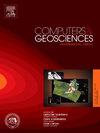Eigenvector decomposition for joint analysis of spatial characteristics in the North Atlantic from 1979 to 2024
IF 4.4
2区 地球科学
Q1 COMPUTER SCIENCE, INTERDISCIPLINARY APPLICATIONS
引用次数: 0
Abstract
The extension of the use of Itô stochastic differential equations (SDEs) for joint analysis of spatio-temporal characteristics in the North Atlantic region, such as sea surface temperature (SST), the sum of sensible and latent heat fluxes, and surface atmospheric pressure for the period between 1979 and 2024 is introduced. Previously, this model was used only for the fluxes. The joint point estimates for the random coefficients of SDEs as multidimensional matrices (the drift vector and the diffusion matrix) are obtained for the entire considered period. The numerical estimations of these values were carried out using high-performance computing equipment with software implementation in Python language using the reanalysis data from the ERA5 database. Developed methods and tools are used for the statistical analysis of the temporal evolution of the coefficients of the Itô equation, analysis of joint and marginal diffusion matrices, their finite-dimensional Karhunen–Loéve’s decomposition into eigenvalues and eigenvectors, determination of their interrelations, temporal trends, as well as dynamic visualization on geographical maps of the region under study. The spatial structure of the eigenvectors of the diffusion matrix, their time evolution and the relationship to jet streams and large-scale heat waves that determine latitudinal heat transfer in the North Atlantic are shown. It is also demonstrated that there is a positive trend in the interannual variability in drift and diffusion coefficients. This indicates a quantitative and qualitative increase in the air–sea interaction and the relationship between heat fluxes and ocean surface temperature. It also makes it possible to quantify the energy exchange between the ocean and atmosphere on an interannual scale. The way of using quantities from a stochastic model to improve the neural network forecasts is also discussed.
1979 - 2024年北大西洋空间特征联合分析的特征向量分解
介绍了Itô随机微分方程(SDEs)在1979 - 2024年北大西洋地区海温、感热通量和潜热通量和大气压力等时空特征联合分析中的推广应用。以前,该模型仅用于通量。在整个考虑周期内,得到了SDEs随机系数作为多维矩阵(漂移向量和扩散矩阵)的结合点估计。利用ERA5数据库的再分析数据,利用高性能计算设备和Python语言软件实现对这些值的数值估计。已开发的方法和工具用于统计分析Itô方程系数的时间演变,分析联合和边际扩散矩阵,分析它们的有限维karhunen - lo分解为特征值和特征向量,确定它们的相互关系,时间趋势,以及在研究区域的地理地图上动态可视化。给出了扩散矩阵特征向量的空间结构、时间演化及其与决定北大西洋纬向传热的急流和大尺度热浪的关系。漂移系数和扩散系数的年际变化也呈正趋势。这表明海气相互作用以及热通量与海洋表面温度之间的关系在数量和质量上都有所增加。这也使得在年际尺度上量化海洋和大气之间的能量交换成为可能。本文还讨论了利用随机模型中的量来改进神经网络预测的方法。
本文章由计算机程序翻译,如有差异,请以英文原文为准。
求助全文
约1分钟内获得全文
求助全文
来源期刊

Computers & Geosciences
地学-地球科学综合
CiteScore
9.30
自引率
6.80%
发文量
164
审稿时长
3.4 months
期刊介绍:
Computers & Geosciences publishes high impact, original research at the interface between Computer Sciences and Geosciences. Publications should apply modern computer science paradigms, whether computational or informatics-based, to address problems in the geosciences.
 求助内容:
求助内容: 应助结果提醒方式:
应助结果提醒方式:


